Intel X58 Motherboard Roundup - What does $300 Get You?
by Gary Key on December 5, 2008 3:00 PM EST- Posted in
- Motherboards
ASUS P6T Deluxe
Features
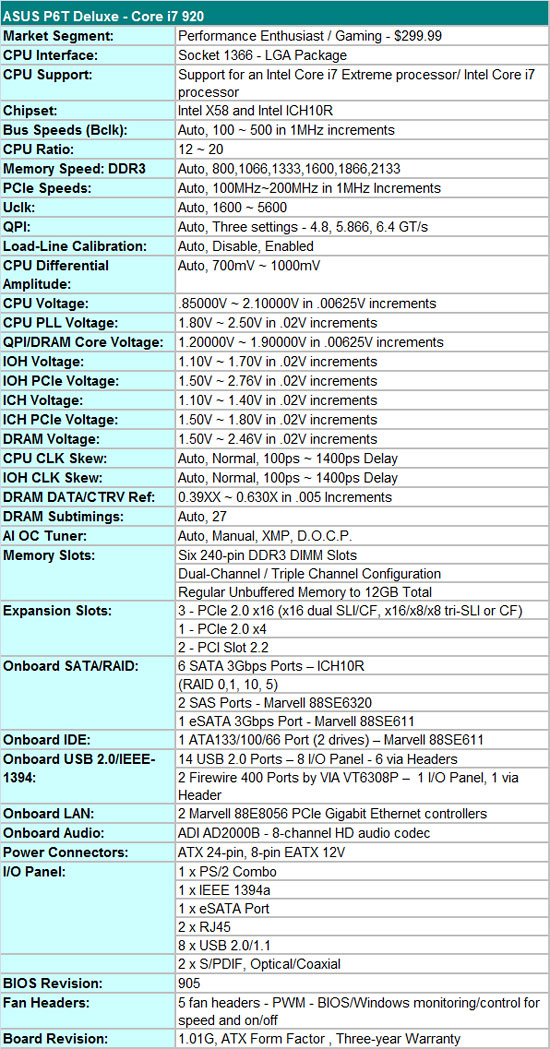
ASUS offers the P6T Deluxe in two different versions, one with the OC Palm external display module for $338 and one without for $299. The OC Palm was originally introduced as the ScreenDuo last year and features a 2.5" QVGA display, four-way directional pad, and four input buttons. It attaches to the motherboard via a USB cable and features a clean, uncluttered, and simplistic interface that allows the user to interface with various ASUS software programs. The user can monitor various hardware functions or do on-the-fly overclocking. The unit allows real-time changes to the processor's Bclk along with voltages for QPI, memory bus, and the CPU. We would like to see additional overclocking variables along with the ability to save profiles to the BIOS or real-time changes to the BIOS. Overall, it is a unique feature and fun to play with for about 30 minutes, but for most users we would suggest saving the money and buying the base board - A board that we might add is one of our favorites in the lab since it first arrived.
Not to take anything away from our other boards as they are all very good with one bordering on being great, but the ASUS P6T-Deluxe impressed us with its ability to just work as expected out of the box. While we provided several suggestions to ASUS for improvements, they mainly centered on tuning aspects, not getting basic functions to work properly before we could even consider testing. That may seem trivial, but unfortunately it is not if you are an early adopter of high-end motherboards.
The BIOS is designed for a wide variety of users who want to get the most out of a board when overclocking. Some of the voltage ranges are not as wide as Gigabyte's, nor do you have the ability to control each individual memory channel, but the options available will more than suffice for most users. We also think the ASUS BIOS is more user friendly due to the information provided for each option. However, ASUS continues to use the terminology QPI/DRAM instead of VTT as the other boards do.
ASUS features memory speeds from 800MHz to 2133MHz memory for the i920/i940 processors along with opening up QPI link speeds from a standard 4.800 GT/s up to 6.400 GT/s. We are disappointed with the number of OC profiles in the BIOS. ASUS has three OC profiles compared to up to eight on the other boards.
The board officially supports 12GB of DDR3 memory, although we expect full support for 24GB in a future BIOS release. Running 12GB of memory on this board is extremely easy and it usually requires less voltage while providing tighter timings than the other boards. Our 12GB Patriot and G.Skill DDR3-1600 kits were 24/7 stable at 1600 with 8-8-8-24 1T timings, although we needed about 1.66V for absolute stability. The Gigabyte board offered slightly better latency results with 9-8-8-24 1T timings, but the ASUS board was just slightly faster in most of the benchmarks except for WinRAR. Of course, your mileage will vary with different memory kits and sub-timings, and outside of memory benchmarks the net difference is generally less than 1%.
One last item of note, at least in this first look, is that the three PCI Express 2.0 x16 slots will operate in x16/x16 mode for 2x SLI/CF if the third x16 slot is empty. If you decide to place a PCIe RAID, network, audio, or TV tuner card in the third x16 slot, then the 2x SLI/CF configuration will operate in x16/x8 mode. We did not notice any performance differences between the two modes with our HD 4870 or GTX 260 cards. 3x SLI/CF configurations will run in x16/x8/x8 mode. You can also use the first and third x16 slots for graphics if you need to open up a PCI slot but the board will run in x16/x8 mode. Although the owner’s manual states the three x16 slots are for graphics cards only, we had no problems running our ASUS Xonar D2X or Highpoint Rocket RAID cards in x16 slot two or three.
The Board
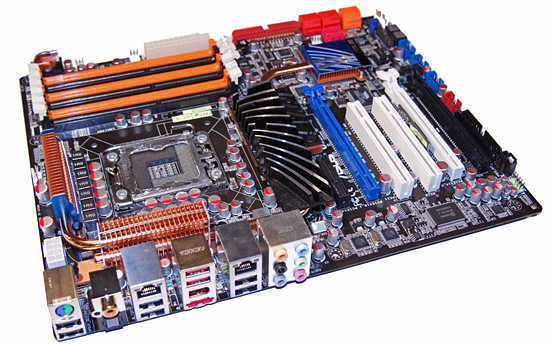
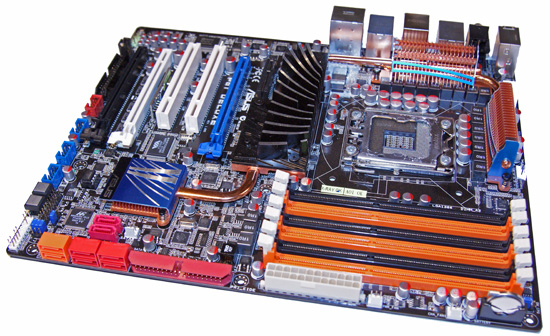
The P6T Deluxe carries over the orange and black decor from previous ASUS DDR3 boards along with a blue and white slot motif. While not exactly as colorful as previous Gigabyte boards or as subdued as the MSI board, it does work well enough; we prefer the flagship ROG color palettes. ASUS has constantly improved their layouts over time and the P6T Deluxe reflects this with a design that is virtually free of clearance problems. While not as loaded as the Gigabyte board, ASUS still has a substantial amount of items to squeeze onto the motherboard.
The first item we notice on the P6T Deluxe is the heatsink and thermal pipe setup encircling the CPU socket area. The CPU socket is centered to the DIMM slots as we noticed on the Gigabyte board. The engineers tell us this is to optimize the memory trace paths resulting in higher overclocks and improved stability. The various heatsinks are low-profile designs featuring a completely passive setup in order to keep noise to a minimum. ASUS utilizes a swept fan design for the northbridge, a small but effective fin array for the ICH10R, and a couple of relatively low-profile fin arrays for the PWM area.
All of this equates to a CPU area that is basically void of clearance issues with large air coolers, although the capacitors are little close to the 1366 socket for the more extreme cooling options. The P6T Deluxe features 23 power phases, which certainly sounds impressive, but we are still not sure if quantity is better than quality in this regard. ASUS dedicates 16 for the processor core and another three memory, two each for the memory/QPI controller and chipset. The Gigabyte and MSI boards feature two individual two-phase designs for the memory and QPI systems.
On the other end of the board we have a bevy of SATA ports and the IDE connector. The six red ports are tied to the ICH10R while the two orange ones attach to a Marvell 88SE6320 Serial Attached SCSI controller. Backwards compatibility built into the SAS standard allows current SATA drives to work. When utilizing a standard SATA drive, performance is close to the ICH10R and definitely a step ahead of the JMicron controllers on the other boards. As a plus, it will do RAID 0 and 1 arrays, and ASUS includes SAS cables in the box. We appreciate the right angle connectors as they ensure there will not be any clearance issues with longer cards. However, ports 5 and 6 use a standard design that results in a very tight fit with a couple of GTX280s installed.
ASUS includes onboard power and reset buttons, but curiously forgot to include a clear CMOS button. After weeks of testing, it is a feature we miss, even though ASUS' BIOS recovery system rarely let us down. Moving forward, we have three physical x16 slots available for graphics in a x16/x8/x8 configuration with a 3X setup. In order to run a 3X setup, the second GPU will have to be a single slot solution... which sort of defeats the purpose of 3-way support, since the current NVIDIA 3-way SLI cards are all dual slot solutions. Still, you can add in a card for PhysX processing if you'd like. In a 2x CF/SLI setup, the user ends up with a x16/x16/x1 configuration. An additional x4 slot is at the top of the board that can accommodate full length cards. To top it off, two PCI slots are available, but the first one will be blocked by double-slot graphics card.
ExpressGate is included on this board and the riser card is located between the second PCIe x16 and PCI slots. In addition to the riser card, the board features onboard headers for an additional IEEE 1394a port and six USB ports. The user ends up with a total of 14 usable USB ports, two more than the ICH10R supports. That means some sharing is going on between the ports, but we never noticed a problem with the board loaded out.
Finally we get to the IO panel that features a single combo PS/2 port, eight USB ports, two Gigabit LAN ports, a single IEEE 1394a and eSATA port, and optical and coaxial S/PDIF out ports. The audio panel features connection jacks to the Analog Devices AD2000B codec, probably the last time we will see this codec since ADI has exited the PC audio business.
The Application
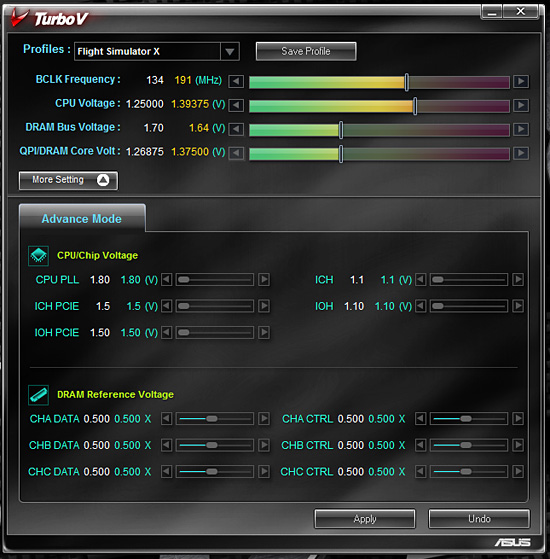
TurboV is ASUS' latest Windows based overclocking utility that features the ability to change most major BIOS settings to improve overclocking rates. It features profiles and works quite well, provided the memory timings and CPU multiplier have been set up properly prior to entering Windows. We are still hopeful that one of the major suppliers will offer the same capabilities as AMD's AOD utility.
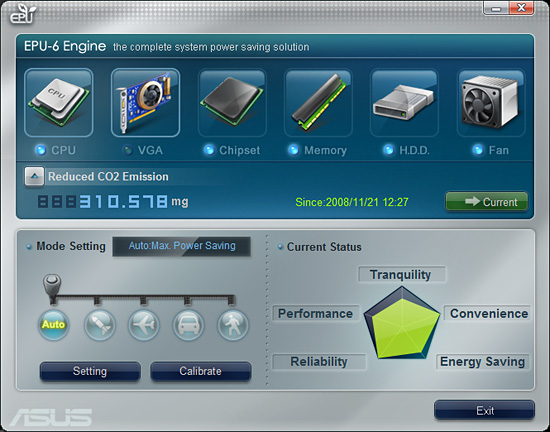
The P6T Deluxe features the EPU-6 power savings technology that can be accessed through the EPU software. The program offers five different modes or levels of energy savings. After hours of testing each setting, we found that leaving the application on Auto with a proper calibration worked best. Utilizing EPU-6 resulted in a power savings of 5W at both idle and load settings.
















78 Comments
View All Comments
mvrx - Wednesday, December 10, 2008 - link
I know these motherboards are months away, but please include dual socket i7 reviews as soon as they become available for testing. My next system will be a dual i7 quad for sure and I'm anxiously awaiting these MB's to come out and mature.I didn't go with current dual socket architectures because of FB-DIMMs limiting the performance and costing so much more. Really hoping to see a resurgance of the dual+ socket enthusiast systems.
And if anyone replies "What can you be using that even takes up a single socket quad core" - well.. then you probably don't know enough about enthusiast computing to reply here. ;-)
strikeback03 - Wednesday, December 10, 2008 - link
I'd think that last line shows why we are unlikely to see a resurgence of multi-socket enthusiast systems. There are very few that have applications which would take advantage of more than 4 physical cores/8 logical cores.mvrx - Thursday, December 11, 2008 - link
Well, I approach it with this logic..... and I get this alot from people.. "few applications that take advantage of more than 4 cores". I'm not running one or two applications....
MS OneCare (or your chosen security suite), seems to zap 15%-20% of overall system performance depending on what it's doing.
Even my old LOTR BFME2 ROTWK game spans 4 cores.. Not very well, but it does.
I run a skype conference server for gamers (an upcoming competitor to Ventrilo) with 20 or so callers on the line at once. Skype (especially skype 4.0) spans many cores reasonably well. (s4pg.us - website's not up yet)
I like to leave my email, web browsers, etc - open when I play my games.. and unfortunately I probably have another 10 active programs sitting in the background in some way. According to resource manager I have about 1100 active threads running, I think the average enthusiast only would have 500-700.
Now, I may be the upper-end of the catagory of heavy resource users, but thats mostly because people don't have the horsepower to do more so they don't. Chicken and Egg issue. If I can get a i7 for $300, and maybe the dual socket MB costs me a $150 premium, I'm sure as heck going to go dual socket.
I know one of my biggest issues is HD performance, but I hope to fix that with one of Micron Tech's new PCIe SSD cards... At that point, I'll probably be easily slamming two i7's. And I do like to run x264 mp4 compression jobs overnight. Even if it only liked using 4 cores, I can run several instances at once.
According to the roadmaps, the X58 is dual socket ready.. So I doubt it will be long until we see at least a few boards.
anindrew - Wednesday, December 10, 2008 - link
I had already ordered and received most of my parts for my new X58/i7 920 based system before this article went up. I was anxiously waiting for it to see what Anand and crew thought. Like so many commented here, I had no idea Anandtech's crew helped sort out issues with motherboards and BIOSes. I think it would be interesting to hear more about that and specifically why you did that (by choice or to help everyone).I built my system yesterday using the Gigabyte GA-EX58-UD5, i7 920, and 6GB of G.Skill DDR3-1600 8-8-8-21 memory (those are the actual specs of it). I have had no problems at all setting the system up. Everything works as it should. I have not tried to overclock yet, but I will since I have the Noctua SE1366.
The Asus P6T does look great, and I am happy to hear that it worked as it should right away. I had to debate between the Asus and Gigabyte boards. In the end, I chose the Gigabyte because I got a $30 discount in a combo with the Geforce GTX260 core 216. Time will tell if I made the right choice. :-)
chuckbam - Tuesday, December 9, 2008 - link
I member of ABXZone.com pointed out to me that the ASUS P6T Deluxe has a memory range conflict on the device I/O APIC controller. Does anyone have more information on this?http://chuckbam.com/Posts/IOAPIC.PNG">http://chuckbam.com/Posts/IOAPIC.PNG
chrhon - Tuesday, December 9, 2008 - link
Thank you for bringing up those comments at the begging of the article. Pretty much everyone I talk to is fed up with motherboard problems and even considering something such as buying from Dell. These mobo manufacturers are shooting themselves in the foot. Sadly the reviews seem to help them.My last build I started with a Gigabyte board and it was good to me but there were complaints on all the reviews on the memory overclocking. Then that board stopped working for me and I bought a DFI board that was universally praised by the reviews and it was the biggest pain in the ass - almost every time I would add or remove a card or flash the BIOS I would go through non-POST hell. I don't see myself EVER buying a DFI board again based on that experience.
If a motherboard company comes out bragging about its quality components and stability THAT is where I am going to put my money. Believe it or not its things like chipset fans being cheap and going out that make more difference in long term satisfaction of a board than one more (when there are already 50) way to tweak some voltages.
Kroneborge - Tuesday, December 9, 2008 - link
Reliability is definitely key. Fast doesn’t matter if your computer won’t run. I do music production, along with my games, and I want a system that is going to run all the time with no problems. If that means I can’t overclock, then I would rather do that. I definitely suggest adding a reliability chart so those of us who need computers for production purposes can factor that in.Also for music production having 12gb or even 24 is perfectly reasonable for large sample libraries. Manufacturers that think supporting those sizes (as advertised) isn’t a priority are wrong.
Thanks for the great review, and please continue to put an emphasis on things working. And keep updating stuff so we know where they stand. I for one won’t be purchasing my new computer till I’m sure I can get it working with little fuss right out of the box.
SiliconDoc - Tuesday, December 9, 2008 - link
That was very kind of you Anand - to point out how the monster that was created is out of control...rofl - I couldn't help thinking - imagining - it's just like the bankers/loan officers/fannie n freddie freaks that fried the economy with wild eyed speculation and housing bubbling... just crazed wackos doing "what must be done" in the name of ... well profits or chest thumping or bonuses or bragging rights or all the above in all cases...
Now the crash and burn of simple motherboard features not even working is splaying out in the public - I've seen the posted reports by the end users...
"We don't have to do it right - or even ethically *advertised features actually work* - seems to be the call of the day everywhere.
So anyway - good job actually EXPERIENCING THE LAST STRAW AND TRYING TO DO SOMETHING ABOUT IT .
Hopefully the pendulum will swing back toward center without anyone getting fragged... (although I'm sure purchasers in some cases wish otherwise).
SiliconDoc - Tuesday, December 9, 2008 - link
PS - Yes, so that I'm not missing something either - it DOES sound like they owe Anand and the staff about a million bucks (each).I can see how a good review here and there has now ballooned into "lab support" ....
A million bucks each ought to do - the manufacturers can take up an R&D collective - if they threaten to cut off boards just do a maniacal laugh - they will crumble and pay up.
;-)
araczynski - Monday, December 8, 2008 - link
mildly interesting, but personally i'd like to see this in comparison to something from the 'normal' lineup, you know, like what most people currently have.throw a C2D/3ghz/4gb in there and then we have something interesting.
compare apples to apples, not just apples to themselves.